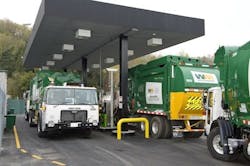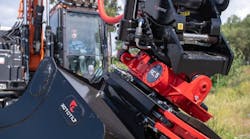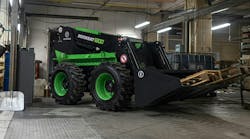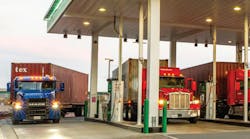Family-owned concrete supplier Ozinga Bros. faced a major decision last year. It hadn’t bought new trucks in six years, and it was time to make some purchases. Tim Ozinga, the company’s director of communications, says they looked at all the options, including biodiesel fuel and compressed natural gas (CNG), eventually settling on CNG.
“We saw it as a way to lower our dependence on foreign oil and as a positive for the environment,” Ozinga says. “The lower fuel cost was just the icing on the cake.”
Natural gas engines are gaining traction in the on-highway side of construction as fuel costs and emissions regulations force equipment managers to look at alternatives to diesel powerplants. As the engines gain acceptance, engine builders are turning their focus to the off-highway market, too.
Mining's LNG Hybrid Conversion
In October 2010, Gaseous Fuel Systems (GFS) unveiled its first liquid natural gas (LNG) mining truck. Its bi-fuel conversion system allows the Cat 777C to operate on 60 percent gas substitution for diesel. In June 2012, the EVO-MT 7930 conversion system was introduced to modify the Caterpillar 793 haul truck, followed by the EVO-MT 7770 for the Cat 777 truck. Both systems seamlessly switch to 100 percent diesel operation in the event of a fault condition or low LNG fuel levels. The company’s bi-fuel conversion systems substitute 50 to 60 percent of its fuel to LNG.
Lanny Slater, director of sales, says safety is a big concern when it comes to mining. Regardless of operating mode, the system will not harm the engine in any way. LNG is also safer, he says.
The refueling process is also simplified, Slater says. A fueling station can operate off the end of a natural gas pipeline, and there’s also the option of using an Orca tank. Orca tanks are portable and can carry about 33,000 liters of fuel.
Slater says there is no difference in the workload capability from diesel to LNG. The initial $500,000 cost for the equipment and fuel tanks is recouped in fewer than than 13 months, he says.
Slater says request for their bi-fuel products has been at an unprecedented high.
“The acceptance from the mine users and mine owners has been phenomenal,” he says. “They cannot believe the savings they’re getting immediately.”
Before, he says, operators would need to fill up every day with diesel. With the LNG substitution, they often go two, two and a half days without putting diesel in the tank.
The spark-ignited natural gas engines in Ozinga’s trucks lower emissions 80 to 90 percent, as compared with traditional diesel. With natural gas, there’s a $1.50 to $2.00 per gallon equivalent savings but there’s also a significantly higher start-up cost involved, Ozinga says. Trucks operating on natural gas cost about 20 percent more than traditional-fueled trucks, but according to Ozinga, the investment pays itself back in about three years.
Scott Fenske, assistant marketing manager at McNeilus, Ozinga’s supplier, says Ozinga was one of the first companies on the mixer side to grasp the concept and benefits of CNG. Prospective customers have shown concern over the safety of natural gas and the possibility of an explosion, Fenske says. The other big concern is whether the power is the same as a diesel engine.
Ozinga says he has no hesitations sending out his CNG trucks and is fully confident they can perform on the same level as diesel trucks.
The CNG engines in Ozinga’s mixers are 6-cylinder, 8.9-liter Cummins ISL G engines paired with Allison transmissions. Cummins Westport, a joint venture between Cummins and Westport Innovations, produces spark-ignited natural gas engines in North America. Cummins first ventured into the on-highway natural gas engine business in 1986, when the engines mostly served environmentally conscious urban bus fleets.
More than 15,000 ISL G engines have been sold into refuse, bus and truck applications since its production start in 2007, according to Roe East, the company’s general manager of on-highway natural gas business. Although lower fuel cost is a key difference between natural gas-powered trucks and those that run on diesel, East says natural gas can be a challenge to store on vehicles. Gas must be compressed and stored in pressurized tanks or cooled and stored in insulated tanks. Either way, the tanks are larger and more expensive.
Natural Gas Engines in the Refuse Industry
One industry that has plunged into using natural-gas-powered engines is the waste-and-refuse industry. Currently 30 percent of the waste-and-refuse market runs on natural gas, says Nadine Haupt, director of alternative fuels at Navistar, and in the future that could go up to 60 or 70 percent.
Waste Management is one of the larger refuse companies incorporating natural gas into their fleet. John Lemmons, director of fleet and equipment performance, says the switch occurred about 10 years ago in an effort to comply with emission requirements mandated for the West coast.
“Going forward, it was an absolute no-brainer,” Lemmons says. “It’s way cheaper than diesel.”
Lemmons estimates an approximate $45,000 up-charge per truck, with an additional $2 million to $3 million cost to build a fueling station. So far, Waste Management has around 40 fueling stations across the country, and it plans to reach 50 by the end of the year.
With the difference in price between diesel and gas, Lemmons estimates a return on investment in approximately two and a half years.
Today, roughly 1,600 of the fleet’s 19,000 trucks run on natural gas. In the next 10 years, Lemmons is hopeful that 80 percent of new-truck purchases will run on natural gas.
Cummins also develops and supplies CNG engines to Navistar, which has partnered with California-headquartered Clean Energy Fuels to build an infrastructure of fueling stations for both CNG- and LNG (liquid natural gas)-powered engines around the country. Clean Energy is looking to build a Natural Gas Highway with 150 new LNG fueling stations.
Although the environmental benefits are indeed relevant, they are no longer the prime factor driving the switch to natural gas, Haupt says, because diesel engine technology has reduced emissions of particulate matter and nitrous oxides. Natural gas does make an impact on the carbon footprint companies are looking to reduce, she says, but natural gas engines emit methane, which is a greenhouse gas. Aftertreatment solutions such as a methane catalyst will negate that, she says.
Haupt recommends companies look closely at specific needs when considering natural gas engines. “People shouldn’t feel that there’s a mad dash to do this right away,” she says. “The fuel price savings is going to be with us for some time. This is not just a flash in the pan.”
The move toward natural-gas engines has begun for off-road equipment. In June, an agreement was made between Westport and Caterpillar to develop natural-gas technology. The companies will first concentrate on mining trucks and locomotives, but they are also evaluating electric power, industrial and machine applications. Westport’s High Pressure Direct Injection (HPDI) technology will be a key component to the partnership.
Development programs are underway, and commercial production is expected to begin in about five years.
Cummins also offers a range of off-highway engines, both CNG and LNG, ranging from 5.9 liters to 91 liters. Those are used primarily in gas compression, power unit, and power generation equipment, says Chris Pritchard, natural gas product manager. Cummins is preparing for a 2013 launch of a new 12-liter engine fit for regional haul and refuse applications; and a 15-liter, heavy-duty, spark-ignited engine called the ISX15 G will be offered beginning in 2015.
For Ozinga, the decision for natural gas has been wise so far. As a relatively new technology for the company, he doesn’t have particular numbers to give, but says fuel cost isn’t the only big perk. Natural gas is very clean burning, he says, and the company expects longer periods of time between maintenance, and an overall longer engine life.





